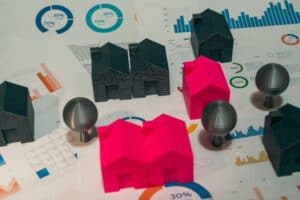
Best Property Investment Courses in the UK
Discover top-rated UK property investment events, bootcamps, and mentors, including Martin Roberts, Stuart and Scarlette

The Decent Homes Standard (or DHS) is a minimum standard that must be met by all social housing in the UK and Northern Ireland. In 2000, the government set the target of 2010 by which all ‘non-decent’ social housing should be improved, or at least improvements should be planned, and reasons given as to why the deadline could not be met. Local authorities are responsible for ensuring their area’s social housing is ‘decent’.
Table of Contents
ToggleThe DHS was also updated in 2006 to include the Housing Act 2004, including the introduction of the Housing Health and Safety Rating System, or HHSRS. The Social Housing Decent Homes Standard Review took place in the autumn of 2021 to review the accepted standards for the social housing sector. This review was reopened in June 2023 and is ongoing at the time of writing (March 2024).
Other laws also apply to social and private rented housing, such as the Homes (Fitness for Human Habitation) Act 2018, which amended the Landlord and Tenant Act 1985. All landlords need to be aware of these laws and make sure their properties are up to scratch, or they could face legal proceedings. So what is the Decent Homes Standard and how can you tell if your property is compliant?
The DHS applies only to social housing at this time, although the government published a policy paper in June 2022 stating their plans to expand the DHS to include privately rented properties too.
Here is a Decent Homes Standard checklist, including all criteria by which a property can be assessed as ‘decent’ under the DHS.
This is defined as not having any category 1 hazards as detailed in the HHSRS – see more on this below.
Properties could fail to meet this criterion if one or more of the key building components, or two or more of the other building components are old and in need of repair or replacement. What is meant by a ‘key component’? These are any components that could impact the integrity of the building and cause deterioration of other components, such as external walls, windows and doors, plumbing, electrics and more. ‘Other building components’ refers to structural elements, e.g. internal walls, services and amenities, e.g. kitchens, bathrooms, heating systems, and more.
Note: this list is not exhaustive and can vary depending on the individual property in question – I recommend you go to this page on the government website for more information.
Properties that lack three or more of the following will fail to meet this criterion:
Source: https://assets.publishing.service.gov.uk/media/5a7968b740f0b63d72fc5926/138355.pdf
With additional information from https://www.highstoneha.co.uk/policies/home/Decent-Homes-Standard.pdf
A property can lack two of the above and still be considered ‘decent’ under these standards, as long as it meets the rest of the criteria.
This means that the property must have effective insulation and heating. Effective insulation depends on the size and type of property as well as the type of heating system installed. Effective heating can include central gas or oil programmable heating, electric storage heaters, warm air systems, underfloor systems, programmable LPG/solid fuel central heating, or any similarly efficient heating methods developed in the future. The heating system must sufficiently heat 2 or more rooms in the property and under the HHSRS, make it warm enough for the occupant. This could vary depending on who lives in the property, e.g. elderly or otherwise vulnerable people.
Source: https://assets.publishing.service.gov.uk/media/5a7968b740f0b63d72fc5926/138355.pdf
With additional information from https://www.highstoneha.co.uk/policies/home/Decent-Homes-Standard.pdf
The HHSRS is a scoring system used for assessing the various hazards that may be present in a property, and the potential effects they can have on the health, safety and well-being of the occupants. Each hazard is classified from Class 1 – Extreme, which could cause death or serious injury, to Class 4 – Moderate, which could cause discomfort or minor injury. Properties with one or more Class 1 hazards would fail the DHS and repair or refurbishment would be required.
The government conducted a review of the HHSRS in 2022 and plans to simplify the system and align it with other legislations and standards. This plan is still underway and is expected to be introduced after the conclusion of the DHS review mentioned above.
There are 29 hazards listed in the HHSRS. These hazards include issues like damp and mould growth, excess cold or heat, carbon monoxide and structural collapse. See this page for the full list of hazards defined by the HHSRS.
An inspection of a property by local authority housing or environmental health officers will assess the presence of any of the above risks and their severity. This is how Category 1 hazards are determined. All properties contain potential hazards, but it is the landlord’s responsibility to reduce the risks by either removing a hazard entirely or taking steps to minimise its effects.
Currently, privately rented properties are not subject to the DHS. This is subject to change soon, due to the government-enacted changes detailed above. This of course may not come to fruition, but in my opinion, you should prepare for it so you can avoid any nasty future surprises. With forthcoming new law changes, private landlords will need to self-declare that their properties adhere to the DHS – it could be a criminal offence to let a property that does not meet the Decent Homes Standard. Current laws already state what conditions are acceptable for privately rented properties such as the the Tenant Fees Act 2019, the Homes (Fitness for Human Habitation) Act 2018, and the Housing and Planning Act 2016.
Are you interested in property investment? Find out insider tips and hacks for budding property investors at one of our FREE events or property investment courses – sign up here.
You May Also Be Interested In...

Best Property Investment Courses in the UK
Discover top-rated UK property investment events, bootcamps, and mentors, including Martin Roberts, Stuart and Scarlette

How to Make a Million Pounds from Property Investing
Discover how to earn £1 million through UK property investing with practical strategies and expert

How To Grow A Property Portfolio – Free Online Training
Grow your UK property portfolio from scratch with expert tips, creative strategies and free online
Featured Property Investment Events & Courses
The Property Deal Packaging Summit
The Property Millionaire Bootcamp
The Serviced Accommodation Bootcamp
Assets For Life LTD is a company incorporated in England and Wales with registered number 09935286 and registered offices at Assets for Life Ltd, Suite 105, Waterhouse Business Centre, 2 Cromar Way, Chelmsford, Essex, England, CM1 2QE, United Kingdom.
Assets For Life LTD is registered with the Information Commissioner’s Office, with registration number ZA280607
COPYRIGHT © 2024 ASSETS FOR LIFE, ALL RIGHTS RESERVED. WEBSITE BY AMPLIFY MARKETING